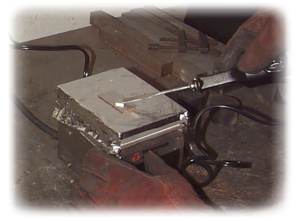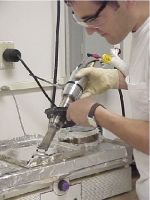Mechanical vs Chemical Fluxing During Solder Bonding
Flux is derived from Latin word fluxus meaning “flow.” In solder joining (also aluminum soldering, graphite bonding, ceramic to metal brazing, etc.), a flux facilitates wetting by molten metals disrupting oxides on metal surfaces which interrupt the reaction/interaction of the molten solder metals with the underlying metal. Additionally, flux allows solder to flow easily on the working piece rather than forming beads as it would otherwise.
In conventional soldering, like aluminum soldering for example, the fluxes used are chemical based cleaning agents that facilitate soldering, by removing oxidation layers from the metals that are being joined. Flux is nearly inert at room temperature, but becomes strongly reducing at elevated temperatures, preventing the formation of metal oxides. Common fluxes are: ammonium chloride or rosin for soldering tin; hydrochloric acid and zinc chloride for soldering galvanized iron (and other zinc surfaces); and borax for brazing or braze-welding ferrous metals. These chemicals are quite corrosive and must be removed or neutralized before a soldered assembly is put in services. Another primary purpose of flux is to prevent oxidation of the base and filler materials. Tin-lead solder (e.g.) attaches very well to copper, but poorly to the various oxides of copper, which form quickly at soldering temperatures.
S-Bond solders are active (with their additions of reactive elements such as Ti and rare earths) and do not require chemical fluxes, in fact the S-Bond bonding processes are “fluxless” since they do not require a chemical fluxing agent to remove oxides off of metals. Since there are no chemical fluxes used, when S-Bond solder bonding the oxides on the surface of melting pools, S-Bond fillers have to be disrupted to enable the active elements to come in contact with the underlying base layers. If the oxide layer formed on molten S-Bond is sufficiently disrupted via mechanical rubbing, brushing or even ultrasonics, then S-Bond will wet and flow over metal, ceramic and carbide materials, setting up the first physical step of solder joining — wetting. [NOTE: S-Bond solder is incompatible with chemical fluxes and they should not be used in combination with S-Bond]. The figures below indicate the disruption of the transparent and thin (~ 20-30 Å) stable rare earth oxide films that form on melting S-Bond.


Active S-Bond solders DO NOT require chemical fluxing, they require mechanically activated “fluxing” to get these active titanium and rare earth activated solders to flow and wet base materials. Hence our use of the term “mechanically activated” solders.
S-Bond can be made to wet and spread on most metals, glasses and ceramic materials via mechanical activated processes like those seen in the images below. These methods are all applicable to spread/wet and activate molten S-Bond (heated to its molten temperature) such that it bonds to metals, ceramics and glass. The images show rubbing using a spatula or other dull-heated metal edge brushing with heated metal bristles, or ultrasonic activated tools which through cavitations, disrupt.




U/S Spreading
Mechanical activation is different from conventional soldering that it uses chemical fluxing to activate the solder bonding process. Such mechanical activation limits S-Bond soldering and precludes it as a commercial solder “reflow” process that uses preplaced solder preforms or paste that integrate chemical fluxes. The added step of mechanical disruption in mechanical activation of S-Bond’s active solders requires a pre-placement of S-Bond as a tinned layer on a heated base surface via pre-tinning by brushing, rubbing or ultrasonic spreading, prior to assembly. Once the layers are preplaced, joining of S-Bond tinned surfaces is facilitated by sliding or rotating the two facing surfaces against one another, or as the images above illustrate, the firing of focused ultrasonic energy through the molten solder interface in order to disrupt the thin rare earth oxide layer surfaces formed on the free S-Bond surfaces.
So, the S-Bond “mechanical activated” process is different than conventional reflow. A negative is high volume production — it certainly is a change that needs to be integrated into production planning since large past investments in reflow processes may negate the advantage of “fluxless” joining. However, despite the differences mechanical activation cause, in many cases active, fluxless S-Bond joining has the advantages of:
1) Elimination of post solder cleaning, an in blind enclosures this is a huge advantage since trapped flux can contaminate optics and electronics.
2) S-Bond solders do not flow regularly without activation, S-Bond solders stay where placed, so solders do not flow extensively to adjacent areas
3) S-Bond solders only adhere to surfaces that have been mechanically activated, therefore any inadvertent flow and contact of excess S-Bond solders can easily be cleaned after bonding is completed.
Please contact us to further discuss how mechanical activated S-Bond joining can be implemented on your assemblies and how your bonded assemblies can benefit from active S-Bond solder joining.
